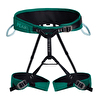Big new climb on Eiger North Face by Silvan Schüpbach, Peter von Känel

 1 / 18
1 / 18 Peter von Känel
Peter von Känel
From 19 to 23 August 2023 Swiss alpinists Silvan Schüpbach and Peter von Känel established a big new climb on the north face of the Eiger. Renaissance has been described as a "bold and elegant" line and was climbed free, except for two short sections. The pair left 8 pegs in-situ and, interestingly, chose not to place any bolts.
Renaissance ascends a steep line on the Rote Fluh on the righthand side of the mountain and initially starts to the right of the Ghilini - Piola Direttissima and then, after crossing this, leads relatively direct through the compact, partly overhanging wall to the right of the Czech Pillar. On the uppermost section the new route follows the Ghilini - Piola for three pitches before finishing direct via three independent pitches. It exits the North Face and joins the West Ridge at 3480m. The pair summited on the 24th and returned to the valley the same day.
Renaissance tackles predominantly excellent rock that accepts a plethora of cams, nuts and pegs. "The lack of bolts gives the route a remarkable originality and seriousness." explained the first ascensionists "The route cannot be simply consumed, it demands commitment. And this massively increases the overall experience and adventure, also because a repeat of the route would feel similar to the first ascent. In addition to being a proficient climber, the route requires a good eye, both to find the right line and to place the trad gear."
After the first ascent 41-year-old Schüpbach explained "In recent years many new climbs have been added to the north face of the Eiger. I've repeated many of these and I'm fascinated by their quality and beauty, which were first ascended with a lot of hard work and skill. These routes all share the fact that they were made possible with the help of electric drills and bolts; the Eiger rock faces are climbed, while the pro is "guaranteed" through the use of modern machines. I don't find this reprehensible in any way, simply a logical development of the climbing.
For a few years I've asked myself whether today's climbing skills can be applied to the Eiger, but with the means of traditional protection? Without bolts therefore? This seemed to me a fascinating challenge.
Chance, luck and skill combined from 19-24 August: one of the last untouched parts of the Eiger enabled us to establish the route in our preferred style, and we got lucky with a weather window that provided us with several days with high temperatures and no precipitation.
We would be pleased if in the future more young mountaineers and climbers would once again rely on traditional climbing - and herald a renaissance in trad climbing on big (and small) walls."
50-year-old mountain guide Peter von Känel explained "Silvan originally discovered this grandiose line and figured it out after much effort. I'm really thankful that he asked me to be his climbing partner. As a team, Silvan and I work really well together and we complement each other perfectly. We also have a similar, slightly offbeat sense of humour and share various culinary delights, such as plenty of mayonnaise and butter.
My climbing level is good, but not outstanding and I quickly reach my physical limit. On the other hand, I can push the boat out in psychologically taxing situations e.g. high above a sketchy piece of gear. Particularly for trad climbing, this is quite useful.
Silvan and I have been working intensively on establishing bolt-free limestone routes for several years. Looking back, I consider our first ascents on Stockhorn and Dündenhorn as stepping stones that eventually led to "Renaissance".
Before Silvan got me hooked on climbing without bolts, I used to use bolts while establishing my alpine multi-pitch outings. Thanks to some rules I'd decided to adhere to, such as ground-up, no bolt ladders, no drilled holes, etc, this type of first ascent provided me with many great adventures, but nevertheless my appetite for peg-free routes grew as my trad climbing experience increased. Also because more or less I've reached my maximum possible climbing level, so I see trad climbing as the next stage in my personal development. Obviously the level at which you can climb is important in trad climbing, too, but it's not the deciding factor. Rather, it requires a balanced mix of different skills.
I feel that the first ascent of "Renaissance" is my apex so far. The combination of climbing, route reading skills, ability to place gear rock and continuously asses the risk allowed me to move efficiently and in control. This, despite the fact that the climb pushed me to my limits several times.
The thought of starting up into virgin terrain with trad gear only always makes me nervous. However, when the time comes and I start climbing, the nervousness gives way to an almost hypnotic focus and clarity. These moments are intense and among the unforgettable highlights of my life.
Before setting off, we'd noticed rock structures in the steepest part of the wall on a aerial photograph that looked like they'd accept gear. However, once we were up there the rock quality really surprised. I consider several pitches as part of my personal "Hall of Fame" of the best rock I have ever climbed. I hope very much that the line will remain free of bolts and thus provide repeat ascensionists with similarly intense moments as we experienced."
Eiger Renaissance
EX, 7c? (7a obligatory) 1220m / 820 vertical meters from Stollenloch, 30 pitches.
Gear used: double ropes 60 m, 2 sets of cams #0.2-2 (totem cams recommended), nuts, peckers, pegs, skyhook, portaledge.
Silvan thanks his sponsors Karpos, Petzl, SCARPA, Exped



 Copia link
Copia link













 See all photos
See all photos






















